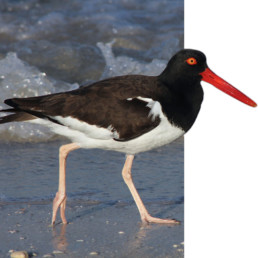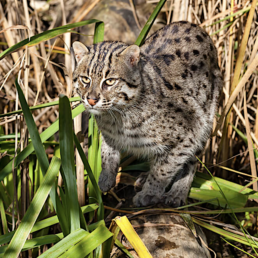Shorebirds know no borders
The long-distance migrations of shorebirds and their mass congregations at important
staging and wintering areas are among the world’s great natural spectacles. Worldwide there are about 217 species of shorebirds and 60% of those are in decline. Many are long distance migrants, nesting in the Arctic and wintering in South America, Africa, and Australasia. They undertake their lengthy migrations in steps, called “stop-over sites” and rely heavily on these key sites for refueling and resting. Of the 50 species of shorebirds that breed in Canada and the US, 41 migrate to overwinter in countries south of the United States. For “our” shorebirds to survive they must have sites to find adequate food and rest in 48 other countries and dependent territories, just in the Western Hemisphere! (Some even migrate into the Eastern Hemisphere.) ICF raises funds to protect these key sites wherever field partners can be found to carry-out field work that aims to halt and reverse declines.
ICF raises funds to protect these key sites wherever field partners can be found to carry-out field work that aims to halt and reverse declines.
Bolivia
Protecting a critical stop on the journey of the Buff-breasted Sandpiper
Goal
To manage a crucial southbound Buff-breasted Sandpiper habitat in the Beni Savanna during the non-breeding season.
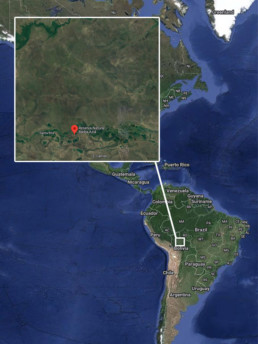
Maps data © 2024 Google
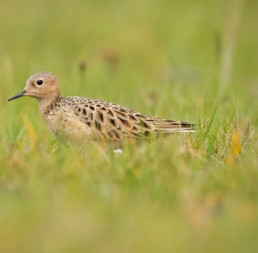
Buff-breasted Sandpiper, Photo: Fabian Pinasco
The Barba Azul Nature Reserve lies at the heart of the Beni Savanna in northwest Bolivia, where local ranch land has been restored using bird-friendly practices. Established in 2008 primarily to safeguard one of the last significant populations of the critically endangered Blue-throated Macaw (known locally as “Barba Azul”), the reserve’s grassland ecosystems play a crucial role for migratory shorebirds, notably the Buff-breasted Sandpiper (Calidris subruficollis). Buff-breasted sandpipers rest and replenish their energy at the reserve while migrating southward.
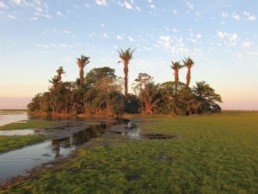
Thanks to the efforts of Asociación Armonía, significant progress has been made within the reserve. While certain fenced areas now remain cattle-free, others are actively managed with cattle to maintain grass heights conducive to migratory shorebirds, notably the Buff-breasted Sandpiper. The establishment of an extensive network of firebreaks has effectively curbed the spread of human-caused fires, allowing the savanna ecosystem to thrive naturally. To enhance tourism infrastructure, upgrades including a new dining facility, improved cabins, solar power installation, and water storage structures have been completed, poised to attract more ecotourists and researchers, thereby increasing revenue.
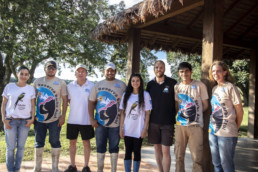
Buff-breasted sandpiper habitat Photo: Bennett Hennessey
How your support can help this project
Asociación Armonía has placed significant emphasis on preserving high-quality grasslands to support several species of shorebirds within the Barba Azul Nature Reserve. Your assistance will aid them in addressing major threats stemming from external factors such as fire, overgrazing, conversion to agriculture, and the spread of invasive plant species.
Chile
Conserving the Rio Maullín watershed for coastal birds
Goal
Protect and enhance the population status of vulnerable migratory shorebirds and resident waterbirds through intensified protection measures at critical shorebird habitats.
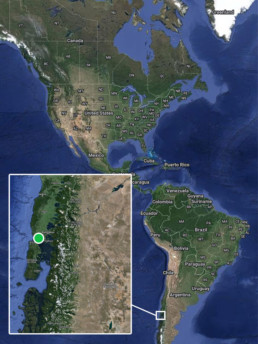
Maps data © 2024 Google

Hudsonian Godwits Photo: Jose Cardenas Vejar
The Maullín wetlands are among the largest coastal wetlands in Chile (25,000 acres). They serve as crucial feeding and resting grounds for Nearctic shorebird species of concern, particularly the Hudsonian Godwit, as well as other waterbirds. The reserves managed by our field partner, Fundación Conservación Marina, play a crucial role for the population of the Hudsonian Godwit as well as the survival of other migratory shorebirds such as Whimbrels, Sanderlings, Yellowlegs, and more. With over 100 species of migratory and resident shorebirds and waterbirds documented in the area, the establishment of a federal Natural Sanctuary spanning most of the Maullín watershed from the mountains to the sea has substantially expanded the conservation footprint.
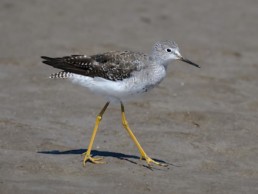
Lesser Yellowlegs, Photo: Fabian Pinasco
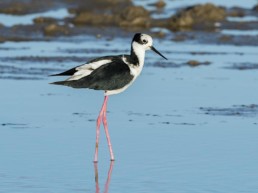
White-backed stilt, Photo: Fabian Pinasco
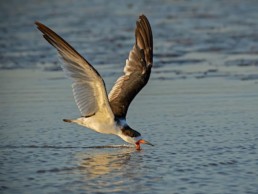
Black skimmer, Photo: Fabian Pinasco
Fundación Conservación Marina is a leader in the protection of the Hudsonian Godwit, a remarkable long-distance migrant. Starting in 2015 with the preservation of a few small wetlands, the effort has expanded to nearly 25,000 acres along the Maullin River. Through strong community engagement and birding tourism promotion, the initiative has created a valuable Reserve Network, securing crucial habitats for migratory birds. This conservation success not only safeguards biodiversity but also provides economic benefits to local communities, ensuring the long-term protection of coastal ecosystems.

Counting Hudsonian Godwits, Photo: Scott Hecker
How your support can help this project
Supporting Fundación Conservación Marina is crucial to safeguarding the vital habitats of migratory shorebirds like the Hudsonian Godwit in Chile’s Maullín wetlands, ensuring their protection for future generations. By backing their efforts, we can contribute to the preservation of biodiversity and the promotion of sustainable ecotourism, benefiting both local communities and the environment.
Argentina
Protecting Magellanic Plovers and Hooded Grebes in Patagonia
Goal
To reverse the decline of the Magellanic plover (Pluvianellus socialis).
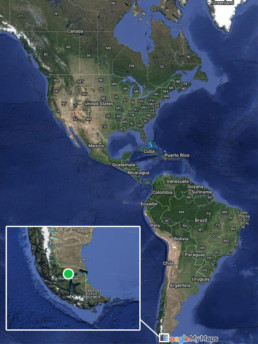
Maps data © 2024 Google
This species has a small global population once estimated to be in the thousands (7,000+) but surveys in 2021-22 indicate that the population has decreased to less than 1,000. A comprehensive survey of known breeding sites recorded just 264 individuals, while the following wintering area surveys recorded 300 individuals (including 55 juveniles). The species is the sole member of the family Pluvianellidae, increasing its conservation significance.
During the breeding season (November to February), our field partner, Aves Argentinas deploys “Plover guardians” survey and protect nests at known and potential breeding sites at remote freshwater lagoons on the high plateaus of Patagonia. When nests are found they are fenced with a “predator enclosure” to increase the likelihood that the nest will not be predated or trampled by sheep. Camera traps are placed at each nest to better understand the success or failure of each nest. Hatchlings and adults are being color-banded to better track their movements and survival.
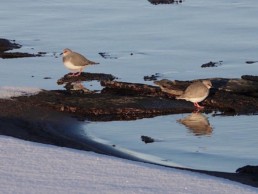
Magellanic plovers on a winter lake
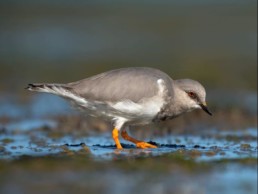
Magellanic Plover, Photo: Fabian Penasco
How your support can help this project
Your donations help pay for field staff to travel to and camp at the sites critically important to this plover’s survival. Funds are used to pay for fuel, food, fencing materials, and all other field supplies needed.
Argentina
Shorebird conservation at Bahía de San Antonio
Goal
Bahía de San Antonio, Atlantic coast of northern Patagonia, 1,000 km south of Buenos Aires.
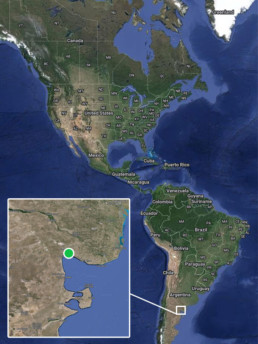
Maps data © 2024 Google
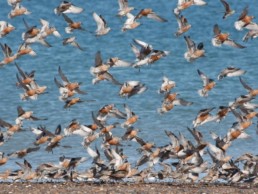
Red knots at San Antonio, Photo: Fabian Llanos
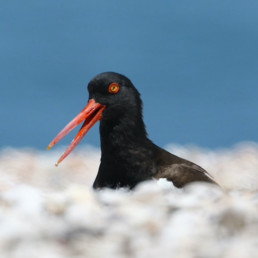
Oystercatcher, Photo: Scott Hecker
Bahía de San Antonio holds significant conservation value, particularly concerning migratory species and shorebirds. Situated along coastal Argentina, this area serves as a crucial stopover point for numerous migratory bird species during their long journeys. The bay’s diverse habitats, including mudflats, salt marshes, and coastal wetlands, provide essential feeding and resting grounds for these birds, offering vital resources for their migration and breeding cycles.
Bahía de San Antonio holds significant conservation value, particularly concerning migratory species and resident shorebirds. Situated along coastal Argentina, this area serves as a crucial stopover point for numerous migratory bird species during their long journeys. The Bay’s diverse habitats, including mudflats, salt marshes, and coastal wetlands, provide essential feeding and resting grounds for these birds, offering vital resources for their migration and breeding cycles.
During migratory seasons, Bahía de San Antonio becomes a bustling hub for migratory shorebirds such as sandpipers, plovers, and terns, among others. These birds rely on the Bay’s rich mudflats and shallow waters as feeding areas to refuel and replenish their energy reserves for their continued journeys. Additionally, the Bay supports various resident shorebird species year-round, contributing to the overall biodiversity and ecological balance of the region.
The rangers of Fundación Inalafquen, actively promote awareness of shorebird and biodiversity conservation within schools and the local community as well as patrolling the beaches as rangers. The foundation also provides decision-makers with expert advice on best practices for shorebird conservation needs. As a result of their successful initiatives, an annual shorebird festival engaging the entire community has been established during the peak migration period.
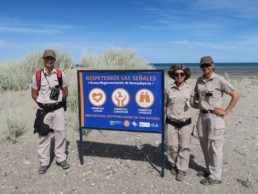
Ranger in San Antonio bay, Photo : Scott Hecker
Despite its designation as a Provincial Coastal Marine Protected Area, Bahía de San Antonio faces growing challenges with increasing coastal development and high levels of recreational tourism that can impact shorebirds at this crucial stopover site. Threats include recreational activities such as the use of ATVs, camper vehicles, motorbikes, and surf kites, as well as the presence of unmanaged loose or feral dogs. Additionally, poorly planned coastal development projects pose a significant risk to sensitive shorebird habitat adjacent to the bay.

Ranger hut, Photo: Scott Hecker
How your support can help this project
Your support will cover paid-beach guardians as well as the materials needed to patrol the sensitive habitats and restrict access (signs, rope, cable fence). Funds can support basic needs such as binoculars, field guides and scopes, and the educational materials used on the beaches.
Mexico
Protecting Red Knots in the Upper Gulf of California
Goal
To protect migratory and wintering shorebirds sites in Northwest Mexico, particularly along the tidal beaches with spawning areas of grunion sardines.

Maps data © 2024 Google

The Golfo de Santa Clara is a biological coastal gem where for thousands of years grunion sardines have arrived in sync with the moon’s tidal cycles and perfect climatic conditions for grunions to arrive, mate, and bury their eggs in the sand where the waves glide in and out. Timed with this annual event is the arrival of many thousands of shorebirds that forage on this abundant food supply. Half of the Pacific population of the threatened Red Knot (Canutus calidris roselaari) times their arrival along that of the grunion mating in order to consume enough food to make the last leg of the journey to their Arctic breeding areas.. Protecting grunions and their eggs also conserves a foundation in the food pyramid for many other species of birds and fish in the Upper Gulf.
Every February, Pronatura Noroeste supports an enthusiastic team of beach guardians known locally as the “pejerreinas” or “grunion queens”. Mostly local women from Golfo de Santa Clara, they rope off grunion spawning areas and intercept and restrict people, vehicles, or pets from entering areas used by thousands of shorebirds during this critical period of their migration and life cycle. They also take advantage of the large crowds (32,000+) inviting them into large beach tents with educational displays and volunteers on hand to answer questions. With years of great success ICF wishes to raise funds for this effort to expand to other nearby locations.
The spring occurrence of the Pacific red knot in the Golfo de Santa Clara coincides with a very popular beach holiday in Mexico, Semana Santa or Holy Week. Thousands of American and Mexican tourists flock to these beaches to camp, enjoy the beach, and party. Trucks and four-wheel drive vehicles conduct races on the beach and in 2018 alone 6 people died and 16 were severely wounded. People harvest thousands of grunions and there has been very little oversight or regulation over what is considered an economic boon to the region.
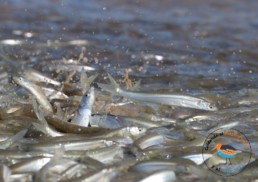
How your support can help this project
Thanks to our generous donors, the 2024 field season is underway and has funds for the start of the year. Your support will cover paid-beach guardians as well as the materials needed to restrict access (signs, rope, cable fence), binoculars, field guides and scopes, and the temporary education used in the beach pavilion.
Southeast Asia
Protecting Spoon-billed Sandpipers in Bangladesh, Myanmar, China, and Thailand
Goal
Reduce the impacts of illegal hunting (netting and nooses) of shorebirds, particularly on the Spoon-billed Sandpiper to stop and reverse their dramatic population decline.
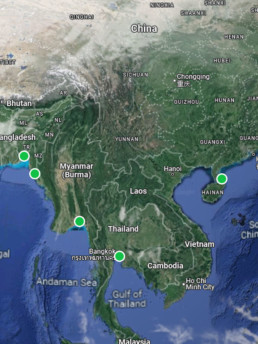
Maps data © 2024 Google
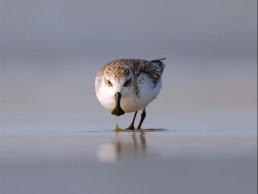
The Spoon-billed Sandpiper, classified as Critically Endangered, breeds in Russia and migrates to Southeast Asia during winter, with only 100 known breeding pairs worldwide. Ongoing conservation initiatives, including this project, offer a glimmer of hope for the species. The intertidal mudflats along the East Asian-Australasian Flyway play a vital role in supporting over 50 million migratory birds annually, including 33 globally threatened species, underscoring the broader benefits of efforts to protect this particular species. Currently, 80 percent of the known population of Spoon-billed Sandpipers spend their winters in Myanmar, Bangladesh, China, and Thailand.
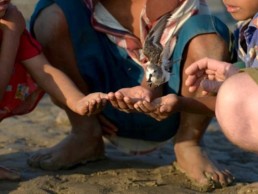
Actions such as guarding sites to prevent hunting, promoting alternative livelihoods in farming and fishing, implementing no-hunting bylaws through Village Conservation Groups, and supporting local non-governmental organizations to raise awareness about the impact of hunting are instrumental in protecting the Spoon-billed Sandpiper.
The Spoon-billed Sandpiper faces numerous threats that contribute to its endangered status. These threats include habitat loss and degradation, particularly the destruction of its breeding grounds in the Arctic tundra due to climate change and human activities such as development and pollution. Additionally, the species is highly vulnerable to hunting and trapping along its migratory routes and wintering grounds, which further diminishes its already dwindling population. Other factors, such as disturbance from human activities and predation, also pose significant challenges to the survival of the Spoon-billed Sandpiper.
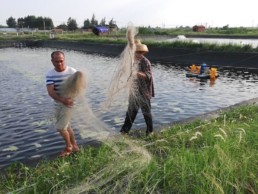
How your support can help this project
Efforts to conserve the Spoon-billed Sandpiper offer a crucial window of opportunity to save the species from extinction.
The fate of many iconic species of shorebirds is hanging by a thread. Many international and local conservation organization are doing their best to save them and they need all the help that they can get. We won't get a second chance to preserve these incredible creatures.
